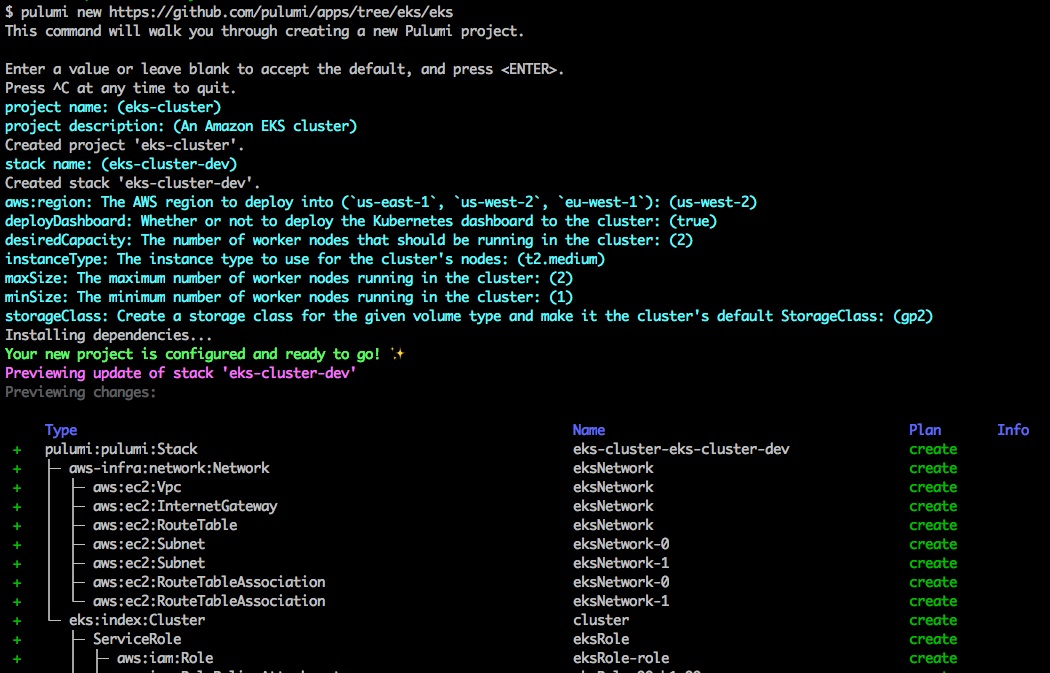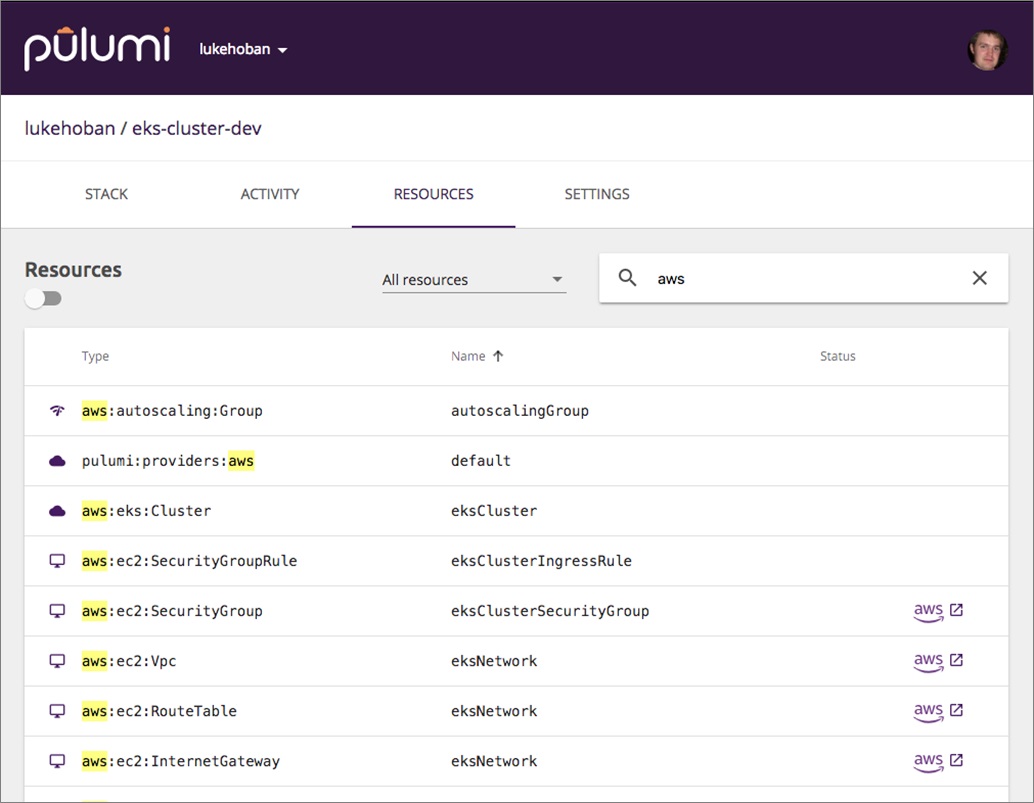Easily Create and Manage AWS EKS Kubernetes Clusters with Pulumi
Posted on
Provisioning, managing, and monitoring a Kubernetes cluster is
not easy. AWS now offers EKS to reduce that burden – but
it’s still difficult to get up and running. Pulumi’s infrastructure as
code SDKs can help! We can provision an entire EKS cluster with a
single CLI command, thanks to the @pulumi/eks
package. Let’s see how.
Updated January 2021 to include Python, .NET, and Go support.
Updated October 2024 to Version 3.0
To get started, download the free and open source
Pulumi SDK, which includes
the pulumi CLI we’ll use below. If you don’t
have the AWS CLI installed and configured, set that up too.
You’ll need AWS credentials to access your AWS account and
provision resources.
From here, there are two ways to proceed:
- Provision a new cluster with a single CLI command
- Use infrastructure as code to manage clusters … including Kubernetes resources themselves!
Installing Amazon EKS with Pulumi
With the Pulumi CLI installed and configured, a single command will provision your cluster:
$ pulumi new https://github.com/pulumi/apps/eks
This template will walk you through configuring a few settings such as the region to deploy, the instance type, and number of cluster nodes.
The CLI will first show you a preview of the AWS and Kubernetes resources that will be deployed to create the cluster, before actually performing any operation. Once you have reviewed and selected “Yes,” the cluster will begin deploying. The terminal output will look like this:

Following these steps will provide a complete managed Amazon EKS cluster, configured similarly to the steps outlined in the Amazon EKS Getting Started guide, including optional support for Amazon EBS-backed StorageClasses and access to the Kubernetes Dashboard. Pulumi replaces all of these tedious, manual steps with a straightforward description of your desired state, and then makes it so!
Once the deployment is complete – it will take 10-20 minutes for
AWS to provision these resources – you can grab the
kubeconfig.json needed to work with this cluster and connect to it
with kubectl:
$ pulumi stack output kubeconfig > kubeconfig.json
$ KUBECONFIG=./kubeconfig.json kubectl get nodes
Reusable AWS EKS component
The Amazon EKS installer we just saw is built on top of a reusable eks.Cluster component that is available in Pulumi’s infrastructure as code solution. In fact, the command above created an instance of this component with reasonable defaults. If you prefer, you can do it by hand and programmatically. Here are examples in each of Pulumi’s supported languages:
import * as eks from "@pulumi/eks";
// Create an EKS cluster.
const cluster = new eks.Cluster("cluster", {
instanceType: "t2.medium",
desiredCapacity: 2,
minSize: 1,
maxSize: 2,
});
// Export the cluster's kubeconfig.
export const kubeconfig = cluster.kubeconfig;
import pulumi
import pulumi_eks as eks
# Create an EKS cluster.
cluster = eks.Cluster(
"cluster",
instance_type="t2.medium",
desired_capacity=2,
min_size=1,
max_size=2,
)
# Export the cluster's kubeconfig.
pulumi.export("kubeconfig", cluster.kubeconfig)
using System;
using System.Threading.Tasks;
using Pulumi;
using Pulumi.Eks.Cluster;
class EksStack : Stack
{
public EksStack()
{
// Create an EKS cluster.
var cluster = new Cluster("cluster", new ClusterArgs
{
InstanceType = "t2.medium",
DesiredCapacity = 2,
MinSize = 1,
MaxSize = 2,
});
// Export the cluster's kubeconfig.
this.Kubeconfig = cluster.Kubeconfig;
}
[Output("kubeconfig")]
public Output<string> Kubeconfig { get; set; }
}
class Program
{
static Task<int> Main(string[] args) => Deployment.RunAsync<EksStack>();
}
package main
import (
"github.com/pulumi/pulumi-eks/sdk/go/eks/cluster"
"github.com/pulumi/pulumi/sdk/v2/go/pulumi"
)
func main() {
pulumi.Run(func(ctx *pulumi.Context) error {
// Create an EKS cluster.
cluster, err := cluster.NewCluster(ctx, "cluster",
cluster.ClusterArgs{
InstanceType: pulumi.String("t2.medium"),
DesiredCapacity: pulumi.Int(2),
MinSize: pulumi.Int(1),
MaxSize: pulumi.Int(2),
},
)
if err != nil {
return err
}
// Export the cluster's kubeconfig.
ctx.Export("kubeconfig", cluster.Kubeconfig)
return nil
})
}
Adding resources, and deploying Helm charts
You can extend or modify this program to change the details of the
Amazon EKS cluster, or to install additional AWS or Kubernetes resources
to associate with the cluster. For example, if applications running in
the cluster need access to an Amazon S3 bucket, create a new
Bucket resource:
const bucket = new aws.s3.Bucket("assets");
bucket = aws.s3.Bucket("assets")
var bucket = new Aws.S3.Bucket("bucket");
bucket, err := s3.NewBucket(ctx, "bucket", &s3.BucketArgs{})
Or, to install Kubernetes applications automatically into the Amazon EKS cluster (such as WordPress), add them using the Pulumi Kubernetes provider pointing at the newly provisioned EKS cluster:
const wordpress = new k8s.helm.v3.Chart("wpdev", {
version: "9.6.0",
chart: "wordpress",
fetchOpts: {
repo: "https://charts.bitnami.com/bitnami",
},
}, { providers: { kubernetes: cluster.provider }});
wordpress = Chart(
"wpdev",
ChartOpts(
chart="wordpress",
version="9.6.0",
fetch_opts=FetchOpts(
repo="https://charts.bitnami.com/bitnami",
),
),
opts=ResourceOptions(provider=cluster.provider),
)
var wordpress = new Chart("wpdev", new ChartArgs
{
Chart = "wordpress",
Version = "9.6.0",
FetchOptions = new ChartFetchArgs
{
Repo = "https://charts.bitnami.com/bitnami"
}
}, new CustomResourceOptions
{
Provider = cluster.Provider,
});
wordpress, err := helm.NewChart(ctx, "wpdev", helm.ChartArgs{
Chart: pulumi.String("wordpress"),
Version: pulumi.String("9.6.0"),
FetchArgs: helm.FetchArgs{
repo: pulumi.String("https://charts.bitnami.com/bitnami"),
},
}, pulumi.Provider(cluster.Provider))
Pulumi makes it possible to define the cluster, AWS resources, and Kubernetes objects needed to bootstrap your entire Kubernetes environment, all in one place. They can then be versioned together and exact replicas of the environment can be created independently for operations such as testing or disaster recovery.
As usual, by expressing these resources in code instead of in YAML, you get many software engineering benefits: improved tooling, the ability to refactor using your favorite IDE, the ability to create and share reusable components, and strong typing to validate correctness up front.
What’s happening under the hood?
To make this whole process buttery smooth, the Pulumi EKS component takes care of setting up all the pieces needed for an Amazon EKS cluster:
- Creating an EKS Service Role
- Optionally creating a new Virtual Private Cloud (VPC)
- Creating an Amazon EKS cluster
- Configuring a Kubernetes provider with access to the Amazon EKS cluster
- Launching worker nodes in an Auto Scaling group to join the cluster
- Installing a ConfigMap into the cluster to allow new Amazon EC2 worker nodes to join
- Installing a StorageClass into the cluster to allow provisioning Amazon EBS-backed PersistentVolumes
- Constructing the
kubeconfigneeded to access the cluster - Optionally installing additional Kubernetes YAML and/or Helm charts
This involves steps that provision resources in AWS, steps that provision resources in Kubernetes, and other custom computation to coordinate these steps. In addition, during the deployment Pulumi also provides complex coordination between these different steps.
Managing Pulumi Deployments
Once you have deployed your Amazon EKS cluster and Kubernetes resources to AWS, you can manage the deployment on app.pulumi.com, including deep links into the AWS console and Kubernetes dashboard to get real-time insights on your cluster.

All of the provisioned resources across AWS and Kubernetes are available from this single view, along with an audit history of deployments to this stack. The stack exports are also published in this same dashboard, so that key outputs, like your kubeconfig, are easily available and can be shared with other users in your organization.
Additional management features, including RBAC, CI/CD integrations, and rich resource graph visualization, are also available via the Pulumi app, including Team and Enterprise Editions for production teams of all sizes.
Get Started
We’ve seen how Pulumi takes care of the heavy lifting with AWS EKS so that you don’t have to. You can use Pulumi to easily deploy new clusters, managed AWS resources, and Kubernetes apps, all with the same powerful toolchain. Support is also available for Azure AKS, Google GKE, DigitalOcean’s Managed Kubernetes, and custom clusters (including Minikube).
For more information:


